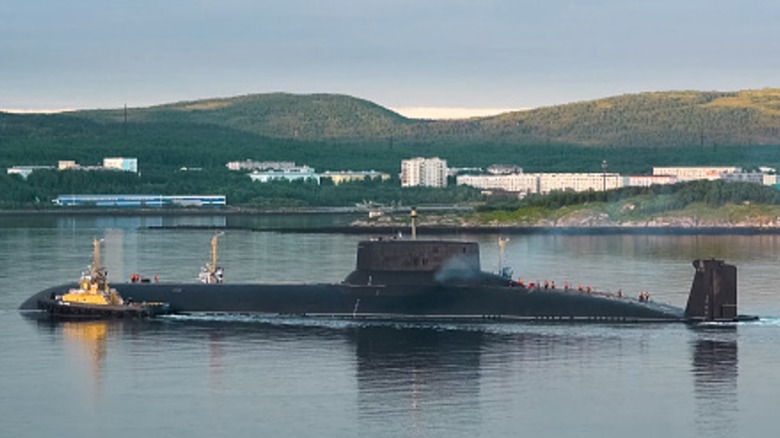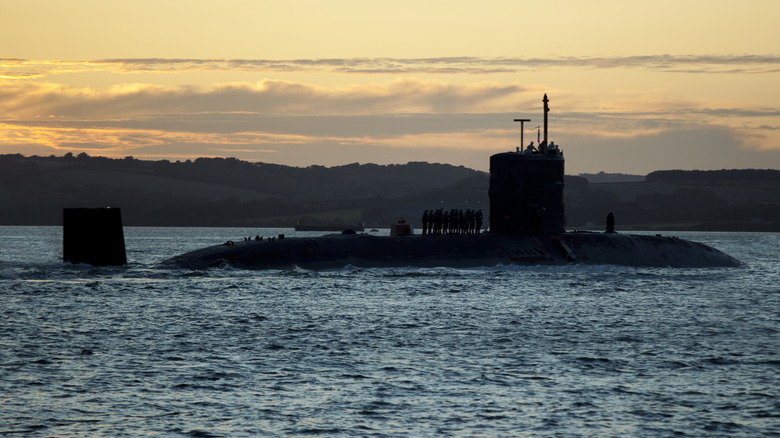Was The Red October A Real Soviet Submarine?
"The Hunt For Red October" is a Tom Clancy novel adapted into a 1990 movie starring Alec Baldwin and Sean Connery. It's about a Soviet ballistic-missile submarine that could run silently through the use of its "caterpillar drive" propulsion system, making it significantly difficult to track. As fun as the film and novel were, and as intriguing as the Red October was with its innovative propulsion system, it was mostly the result of Clancy's imagination. However, the class of submarine used was very real. Soviet Typhoon-class subs weren't just among the biggest, they were the biggest military submarines ever made. And high on the list of the best submarines of the Cold War era.
They didn't have the caterpillar drive, but a sub of the Typhoon class was outfitted with luxurious amenities for its crew of 160 to enjoy, including a sauna, swimming pool, and a gymnasium. It also had two parallel pressure hulls surrounded by the outer hull. This beast of a vessel was 566 feet long and 76 feet wide. By comparison, America's Ohio-class ballistic missile submarine has a hull only 42 feet wide.
It carried 20 RSM-52 submarine-launched ballistic missiles — the Red October was said to carry six more than the real Typhoon-class subs — and was powered by two pressurized-water nuclear reactors that could propel it to 27 knots while submerged. And while "The Hunt for Red October" is a work of fiction, there are some small details based in reality.
There was some truth
The plot of "Red October" is about Sean Connery's character, Marko Ramius — a Soviet submarine captain — disapproving of the direction the USSR was headed, so he steals the Soviet navy's most advanced submarine and defects to the United States. In real life, Valery Sablin was an ardent communist who believed that Soviet leader Leonid Brezhnev was twisting the system to meet his own selfish ends. So Sablin set himself on a rebellious path there was no coming back from: steal a Soviet vessel.
The ship Sablin stole wasn't a modified Typhoon-class ballistic-missile submarine; it was a Baltic Fleet destroyer called the Storozhevoy. And unlike Clancy's fictional Ramius, Sablin had no intention of defecting. He wanted to lead a revolution that would redeem communism for the Soviet Union. Sablin was the political officer aboard the Storozhevoy, giving him and like-minded sailors the opportunity to mutiny and slink off in the middle of the night — in the midst of a celebration for the Bolshevik Revolution, no less.
As soon as Brezhnev learned about the mutiny, he sent maritime planes and patrol ships out in search of it, ordering them to sink the Storozhevoy. However, several ships and planes refused to do so, giving the impression that Sablin's revolution would take off. Unfortunately for him, it didn't. The Soviet air force and marines had no such scruples and disabled the ship before taking the mutineers into custody. Moscow put Sablin to death in August, 1976.
The US tried to make the Red October's stealth system
Tom Clancy had a habit of basing his stories' technology in reality. He unwittingly divulged classified information in "The Hunt for Red October" about the Soviet sub's navigational system, except it wasn't a system used on any Soviet sub, but a feature on U.S. submarines that measured gravitational differences from place to place, making it possible to steer without using telltale sonar pings.
The "caterpillar drive" was also based on technology that existed well before the novel's 1984 publication. The Defense Advanced Research Projects Agency is working on a magnetohydrodynamic drive that doesn't use any moving parts, but still propels a vessel forward. It's a hollow tube with magnetic coils around it and electrodes at one end. They work together to generate a magnetic field known as the Lorentz force that pushes seawater through the tube, propelling the vessel forward almost silently. It would still produce small sounds, but they could easily be mistaken for the ocean's natural ambience.
This would help submarines hide while also improving intelligence-gathering missions by eliminating background noise when sonar gathers data. The concept was tested in 1992 with some success, but the drive was too heavy and couldn't push a 100-foot ship faster than 6.6 knots. Those magnets produced only 30% efficiency, but magnets are much better now and scientists discover new magnets all the time. Right now the defense projects agency is working to develop better electrodes that don't corrode from saltwater.


